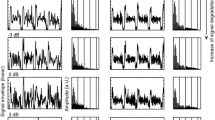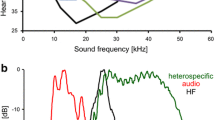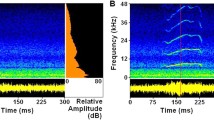Abstract
The detection of acoustic communication signals in the presence of sinusoidally amplitude modulated noise was investigated in males of the grasshopper Chorthippus biguttulus. The auditory system of grasshoppers exhibits only poor spectral resolution. Hence, these animals are ideally suited to investigate noise tolerance in a system operating in the temporal domain. As a sensitive indicator for signal recognition the conspicuous phonotactic turning responses of males were recorded. The main result was that noise modulated at low frequencies (1.5–5 Hz) did not impair recognition compared to a unmodulated noise. With long stimuli even a moderate improvement of noise tolerance was observed, an effect that can probably be attributed to the existence of long troughs at low modulation frequencies during which the masking of the signal was reduced. Higher modulation frequencies (15–150 Hz), however, rendered detection and recognition increasingly difficult, due to a strong interference of the sound pulses of the masking noise with the syllable-pause structure of the species-specific signals. There are no indications for the operation of mechanisms analogous to comodulation masking release as found in vertebrates, nor for a spatial release from masking.



Similar content being viewed by others
Explore related subjects
Discover the latest articles and news from researchers in related subjects, suggested using machine learning.References
Buus S (1985) Release from masking caused by envelope fluctuations. J Acoust Soc Am 78:1958–1965
Buus S (1998) Auditory masking. In: Crocker MJ (ed) Handbook of acoustics. Wiley, New York, pp 1147–1165
Ewert SD, Verhey JL, Dau T (2002) Spectro-temporal processing in the envelope-frequency domain. J Acoust Soc Am 112:2921–2931
Gerhardt HC, Huber F (2002) Acoustic communication in insects and anurans. University of Chicago Press
Gerhardt HC, Klump GM (1988) Masking of acoustic signals by the chorus background noise in the green treefrog: a limitation on mate choice. Anim Behav 36:1247–1249
Givois V, Pollack GS (2000) Sensory habituation of auditory receptor neurons: implications for sound localization. J Exp Biol 203:2529–2537
Grafe TU (1996) The function of call alternation in the African reed frog (Hyperolius marmoratus): precise call timing prevents auditory masking. Behav Ecol Sociobiol 38:149–158
Grafe TU (1999) A function of synchronous chorusing and a novel female preference shift in an anuran. Proc R Soc Lond Ser B 266:2331–2336
Greenfield MD (1994) Synchronous and alternating choruses in insects and anurans: common mechanisms and diverse functions. Am Zool 34:605–615
Hedwig B (1990) Modulation of auditory responsiveness in stridulating grasshoppers. J Comp Physiol A 167:847–856
Helversen D von (1984) Parallel processing in auditory pattern recognition and directional analysis by the grasshopper Chorthippus biguttulus L. (Acrididae). J Comp Physiol A 154:837–846
Helversen D von (1997) Acoustic communication and orientation in grasshoppers. In: Lehrer M (ed) Orientation and communication in arthropods. Birkhäuser, Basel, pp 301–341
Helversen D von, Helversen O von (1975) Verhaltensgenetische Untersuchungen am akustischen Kommunikationssystem der Feldheuschrecken (Orthoptera, Acrididae). I. Der Gesang von Artbastarden. J Comp Physiol 104:273–299
Helversen D von, Helversen O von (1995) Acoustic pattern recognition and orientation in orthopteran insects: parallel or serial processing? J Comp Physiol A 177:767–774
Helversen D von, Helversen O von (1997) Recognition of sex in the acoustic communication of the grasshopper Chorthippus biguttulus (Orthoptera, Acrididae). J Comp Physiol A 180:373–386
Helversen D von, Helversen O von (1998) Acoustic pattern recognition in a grasshopper: processing in the time or frequency domain? Biol Cybern 79:467–476
Helversen O von, Helversen D von (1994) Forces driving coevolution of song and song recognition in grasshoppers. In: Schildberger K, Elsner N (eds) Neural basis of behavioural adaptations. Fischer, Stuttgart, pp 253–284
Houtgast T (1989) Frequency selectivity in amplitude-modulation detection. J Acoust Soc Am 85:1676–1680
Jacobs K, Otte B, Lakes-Harlan R (1999) Tympanal receptor cells of Schistocerca gregaria: correlation of soma positions and dendrite attachment sites, central projections and physiologies. J Exp Zool 283:270–285
Klump GM (1996) Bird communication in the noisy world. In: Kroodsma DE, Miller EH (eds) Ecology and evolution of acoustic communication in birds. Comstock, Cornell University Press, Ithaca, pp 321–338
Klump GM, Langemann U (1995) Comodulation masking release in a songbird. Hear Res 87:157–164
Kroodsma DE, Miller EH (eds) (1996) Ecology and evolution of acoustic communication in birds. Comstock, Cornell University Press, Ithaca
Lang F (2000) Acoustic communication distances of a gomphocerine grasshopper. Bioacoustics 10:233–258
Lehmann GUC, Heller K-G (1998) Bushcricket song structure and predation by the acoustically orienting parasitoid fly Therobia leonidei (Diptera, Tachinidae, Ormiini). Behav Ecol Sociobiol 43:239–245
Moore BCJ (1992) Across-channel processes in auditory masking. J Acoust Soc Jpn E 13:25–37
Moore BCJ, Borrill SJ (2002) Tests of a within-channel account of comodulation detection differences. J Acoust Soc Am 112:2099–2109
Pollack GS (1988) Selective attention in an insect auditory neuron. J Neurosci 8:2635–2639
Pollack GS (1998) Neural processing of acoustic signals. In: RR Hoy, AN Popper, RR Fay (eds) Comparative hearing: insects. Springer, Berlin Heidelberg New York, pp 139–196
Pollack GS (2000) Who, what, where? Recognition and localization of acoustic signals by insects. Curr Opin Neurobiol 10:763–767
Richards DG, Wiley RH (1980) Reverberations and amplitde fluctuations in the propagation of sound in a forest: implications for animal communication. Am Nat 115:381–399
Römer H (1976) Die Informationsverarbeitung tympanaler Rezeptorelemente von Locusta migratoria (Acrididae, Orthoptera). J Comp Physiol 109:101–122
Römer H (1992) Ecological constraints for the evolution of hearing and sound communication in insects. In: DB Webster, RR Fay, AN Popper (eds) Evolutionary biology of hearing. Springer, Berlin Heidelberg New York, pp 79–93
Römer H (1998) The sensory ecology of acoustic communication in insects. In: RR Hoy, AN Popper, RR Fay (eds) Comparative hearing: insects. Springer, Berlin Heidelberg New York, pp 63–96
Römer H, Krusch M (2000) A gain-control mechanism for processing of chorus sounds in the afferent auditory pathway of the bushcricket Tettigonia viridissima (Orthoptera; Tettigoniidae). J Comp Physiol A 186:181–19
Römer H, Bailey WJ, Dadour I (1989) Insect hearing in the field. III. Masking by noise. J Comp Physiol A 164:609–620
Ronacher B, Krahe R (1998) Song recognition in the grasshopper Chorthippus biguttulus is not impaired by shortening song signals: implications for neuronal encoding. J Comp Physiol A 183:729–735
Ronacher B, Krahe R, Hennig RM (2000) Effects of signal duration on the recognition of masked communication signals by the grasshopper Chorthippus biguttulus. J Comp Physiol A 186:1065–1072
Ryan MJ (1985) The Tungara frog. A study in sexual selection and communication. University of Chicago Press, Chicago
Schul J, Helversen D von, Weber T (1998) Selective phonotaxis in Tettigonia cantans and T. viridissima in song recognition and discrimination. J Comp Physiol A 182:687–694
Schwartz JJ, Gerhardt HC (1989) Spatially mediated release from auditory masking in an anuran amphibian. J Comp Physiol A 166:37–41
Tougaard J (1998) Detection of short pure-tone stimuli in the noctuid ear: what are temporal integration and integration time all about? J Comp Physiol A 183:563–572
Wolf H (1986) Response patterns of two auditory interneurons in a freely moving grasshopper Chorthippus biguttulus. 1. Response properties in the intact animal. J Comp Physiol A 158:689–696
Wolf H, Helversen O von (1986) "Switching-off" of an auditory interneuron during stridulation in the acridid grasshopper Chorthippus biguttulus L. J Comp Physiol A 158:861–871
Zuk M, Kolluru GR (1998) Exploitation of sexual signals by predators and parasitoids. Q Rev Biol 73:415–438
Acknowledgements
We thank Stephan Loschen and Johannes Zander for help with the behavioural experiments and Astrid Franz and Matthias Hennig for many discussions and for valuable comments on the manuscript. We also thank two anonymous reviewers for helpful suggestions. This work was supported by a grant from the Deutsche Forschungsgemeinschaft to B.R. All experiments complied with the current German legislation concerning animal care.
Author information
Authors and Affiliations
Corresponding author
Rights and permissions
About this article
Cite this article
Ronacher, B., Hoffmann, C. Influence of amplitude modulated noise on the recognition of communication signals in the grasshopper Chorthippus biguttulus . J Comp Physiol A 189, 419–425 (2003). https://doi.org/10.1007/s00359-003-0417-z
Received:
Revised:
Accepted:
Published:
Issue Date:
DOI: https://doi.org/10.1007/s00359-003-0417-z




